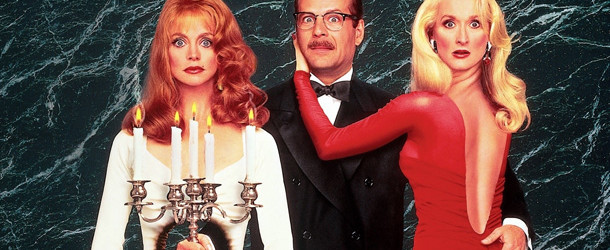“Death Becomes Her” has one of the most creative twists on the zombie genre out there and one of the creepiest messages. Though the movie is a hilarious satire of beautiful women unwilling to face their age, its comedy remains dark. Twenty years has passed since this movie was released, and it’s kind of ironic to note that both actresses, Meryl Streep and Goldie Hawn, seem to have trouble facing this in reality. Hawn has had some questionable facelifts, and Streep takes roles that are 25 year too young for her (Mamma Mia, anyone?). I would hope that neither actress is vain enough to take such extremes as their characters in this film, but playing aging women is definitely something these actresses didn’t have to dig deep to channel.
That’s not to take anything away from these two fantastic performances—this is the movie that first made me a fan of Streep. This is her finest, most brilliant comedic performance captured on camera. She may be more remembered for later hits such as “The Devil Wears Prada,” “It’s Complicated,” or “Julie & Julia,” but fans will recall washed-up actress Madeline Ashton as her most underrated role. If this performance were high notes, Streep would be chirping them with ease.
In her efforts to remain young, Madeline and long-time rival Helen Sharp (Hawn) partake of a magic potion offered by a mysterious phantom beautician Lisle Von Rhoman (Isabella Rossalini at her best). These two appear to have a history of hating each other throughout their entire lives, competing for the same men, with Streep ultimately reining victorious. But now, both women have been murdered, but the magic potion keeps them alive forever, forcing to watch their bodies turn to corpses. Fortunately, Madeline is (unhappily) married to plastic surgeon-turned mortician Ernest Menville—also her murderer, and former fiancé of Helen, played by Bruce Willis, who gives the two much-needed manufacturing. The only problem… he won’t live forever.
Willis is much younger than his female counterparts, but makeup and his character’s lethargies—thanks to Willis’ underrated comedic abilties, allow excellent chemistry between the three. Goldie Hawn’s Helen transforms from a mushroom-haired Plain-Jane to a striking rubicund sex kitten. As this is a comedy, Hawn is in her comfort zone here. Director Robert Zemeckis has a gift with actors, letting them to show the ends of their ranges without them appearing strained. None of these actors could have given these virtuoso performances without his direction.
Acting aside, Mr. Zemeckis’ signature is written all over this one. Though it goes against Hollywood’s Golden Age purist creed that the camera shouldn’t be heavily emphasized, his camera work here is flawless. Zemeckis offers long, panning shots that appear effortless in their ability to let the screen remain balanced. This is the kind of skill that matches Stanley Kubrick. When released, this movie also featured groundbreaking special effects, convincingly showing the seamless deformities of walking corpses Madeline and Helen. And the tenor of the film remains consistent throughout, largely thanks to Alan Siverstri’s pulsating, melodramatic score.
There are a lot of mythological nuances involved here. While watching the film, an overlying motif involving the use of mirrors is pretty noticable. Almost every scene features one. There’s a lot that can be read into it. Perhaps being preoccupied with one’s reflection is the cause for such vanity—a throwback to Narcissus. These women, much like Narcissus, only loved themselves for their looks. As a result, their self-fulfilling punishment, in the same vain as the Roman myth, is to remain forcefully preoccupied with their image until their deaths. Even Narcissus was brought to his reflection through Nemesis, as these two women were reminded of their looks through their own nemesis—each other.
Sadly, this movie remains as the lowest grossing film in Zemeckis’ repertoire since his breakout hit, “Romancing the Stone.” Critics of its day didn’t appreciate it enough. Though a filmed subplot featuring Tracy Ulman had been part of the initial edit, it wound up on the cutting room floor, which is perhaps why critics found the film too empty-headed in 1992. But a thoughtful and heavy movie criticizing vanity? It wouldn’t work. It has to be a satire to succeed, and the film is first-rate as is.
Satires such as this often walk a fine line between being too playful or being too nasty. “Death Becomes Her” has the equilibrium of an ever-spinning top, lashing out mordant, yet affecting commentaries about the reality of age. It mirrors (pun intended) the emphasis our society places on youth.
Let’s face it, age sucks. Past a certain age, no one wants to grow old and watch their body whither before their very eyes. Alas, it’s something we all must face, male or female, and a preoccupation to remain young serves counterproductive, as that line of thinking is what makes one appear old. One of the best lines is delivered by Rossalini: “This is life’s ultimate cruelty. If offers us a taste of youth and vitality, and then it makes us witness our own decay.” I never felt the sting of that line when I was in my teens, but now, in my late-20s, it’s creepy as hell. “Death Becomes Her’s” message, ironically, will remain timeless: The only thing that doesn’t age is mankind’s obsession to stay young.








